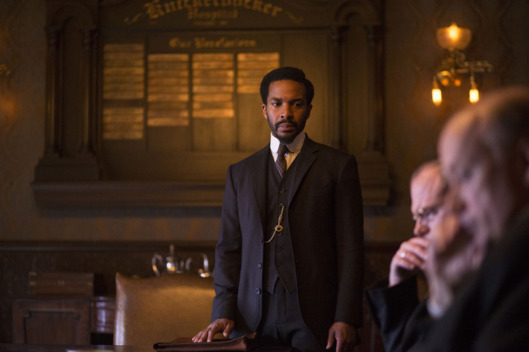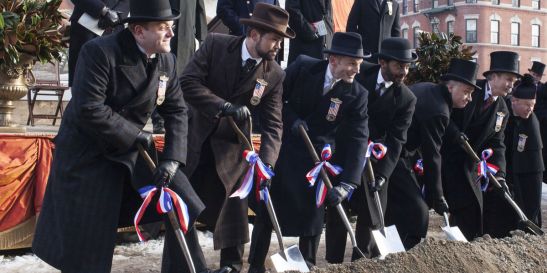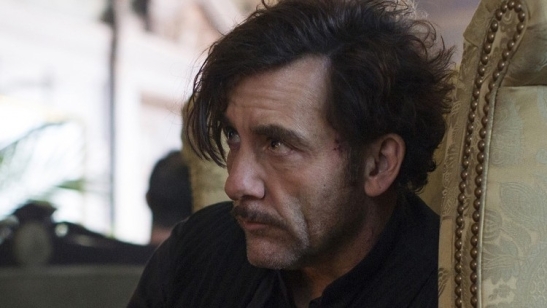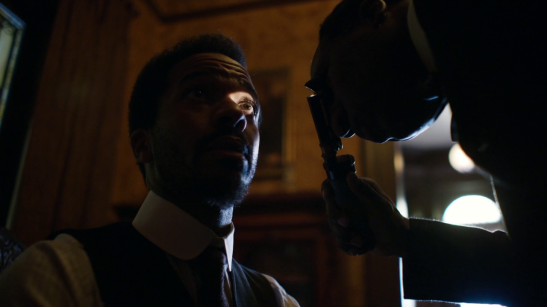The Knick, “Ten Knots”
Kino-eye = kino-seeing (I see through the camera) + kino-writing (I write on film with the camera) + kino-organization (I edit).
Dziga Vertov, 1929, and probably Steven Soderbergh, 2015
Any review of The Knick you read will comment on its direction. This is partially due to the prestige of the director of every episode (Soderbergh), who’s not merely some hired hand. This is partially due, too, to the fact that the scripts and characterization on The Knick – while engaging enough – take a backseat in every scene to Soderbergh’s wild, roving direction; an aspect of the show that opposes the conventional wisdom that television is a “writer’s medium.” And this is due, most of all, to how active, challenging, and compelling every frame of every episode has been thus far. Whether you look at The Knick and see Vertov’s kino-eye or Rouch’s cinéma vérité (and of course, the latter is the descendant of the former), you must see that it’s unlike anything on TV, or anywhere else.
To ground this in more solid concepts: the second season premiere picks up a few months after the first season finale left off. The Knickerbocker Hospital’s former Chief of Surgery, Dr. John Thackery (Clive Owen), is in a primitive rehab facility, where he’s performing nose surgeries (we see him correcting a deviated septum in the episode’s opening moments; if you’re squeamish, you’d better find a new show to watch) in exchange for extra vials of the drug he’s being given to help ease the pain of coming off cocaine: heroin. He’s a mess: twitchy, paranoid, covered with sores, thin and gaunt and crazy-looking. The acting Chief of Surgery, Dr. Algernon Edwards (André Holland), is still brilliant, still black, and now suffering a detached retina as a result of all the self-sabotaging fistfights he’s gotten into in the back alleys of Harlem. He wants to be considered for the permanent position of Chief, but, well, he’s black and it’s 1901. Edwards’s former secret love, Cornelia “Neely” Showalter, née Robertson (Juliet Rylance), is in San Francisco with her dull husband, where she tries to meddle benevolently on behalf of the city’s Chinatown: after a couple of cases of bubonic plague, the mayor ordered Chinatown to be quarantined, with no food coming in and no people coming out. Nurse Lucy Elkins (Eve Hewson) seems to pine for Thack, but also evaluates her options, giving an expensive birthday gift to her former admirer. Said admirer, Dr. Bertram “Bertie” Chickering (Michael Angarano), is visibly frustrated by his increased workload, stagnant career, and imbecilic fellow doctors. Would-be Deputy Chief of Surgery (under Thack only), Dr. Everett Gallinger (Eric Johnson), has welcomed his crazy wife back home and devised a way to get Thack back at the Knick – thereby avoiding having to work under the man he sees as his racial inferior, Dr. Edwards. The Knick’s Director, Herman Barrow (Jeremy Bobb), is now “owned” by a new pimp, Ping Wu (Perry Yung); Ping sees the business opportunity inherent in his access to a hospital director, and commands Barrow to allow him to bring his girls there to make sure they’re “clean.” Sister Harriet (Cara Seymour) is in a women’s penitentiary, awaiting trial for performing abortions; her fellow Irishman and erstwhile protection, Tom Cleary (Chris Sullivan), vows to hire her a fancy lawyer so she’ll be free.
In lesser hands, this could all feel quite soapy. I don’t think the writing is terrible, but it’s conventional, and a hack director could easily emphasize the salacious aspects without noticing the more compelling human drama at play. Soderbergh gets that human drama – and a hell of a lot more. For instance, he doesn’t shy away from the near-Othello levels of tragedy that threaten to overtake Edwards. Much of this is due to Holland, obviously. He’s an extraordinary actor who imbues Algie with all kinds of complexity: erudition, wit, irascibility, yearning, despair, determination, hopelessness; and often all in the same scene. But Soderbergh knows not to focus solely on the calcified white people standing in Edwards’s way. When the hospital board discusses the prospect of hiring a new Chief of Surgery, while Edwards is still in the room, after he’s announced that he’d like to be considered for the post, Soderbergh focuses on Holland’s combined dejection and rage. Just as you focus mostly on how you react to important news, not so much on the person delivering that news, so does Soderbergh appropriately single out the character experiencing the greatest emotional impact of a given pronouncement – and keep his camera trained on that actor, never flinching, never letting the audience miss a tear or a flinch or an eye roll.
Matt Zoller Seitz wrote a phenomenal profile of Soderbergh for Vulture recently, after following him around on set for a day. I can’t recommend it too highly, because it touches on much of what makes The Knick so extraordinary – even among the current crop of extraordinary television drama. Soderbergh is an active participant in each scene, a kino-eye searching out the most interesting aspect of each character and each scene. His camera allows him to use the kind of light that would have existed in the early 1900s – and nothing more. He uses lamplight, candlelight, streetlight, harsh and milky daylight. The stark intimacy is startling, whatever you compare it to. It doesn’t look like anything else on TV, or anything else in the movies. Consider Fargo and Hannibal, my other two favorite dramas this year. They’re stunningly framed, composed, and shot, of course; Hannibal in particular looked like a painting in more scenes than not. But they’re clearly made with big cameras, big lights, big everything. That’s not a bad thing, of course. However, by comparison, The Knick feels almost like guerilla filmmaking, like something of a piece with The Battle of Algiers instead of any other period drama.
In other words, you should watch it. I will re-emphasize that the surgery scenes are gruesome. If you don’t have a strong stomach, this isn’t the show for you. But frankly, you should get over your aversion to blood and knives, your aversion to being an easily broken sack of meat and bones, and just tune in.
N.B. Next week’s post will focus slightly more on the actual episode – but for this installment, I wanted to convey just how fucking great The Knick is. Whether I succeeded or not, watch it. Thank me later.





